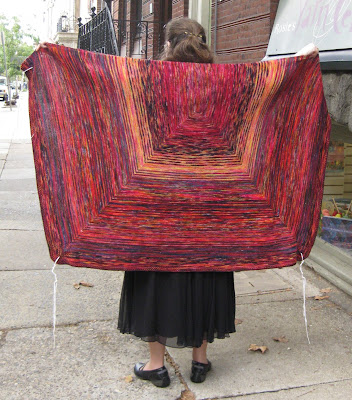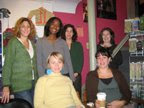It was not just an excuse to collect red skeins of Koigu, no matter what anyone says.
From a ritual standpoint, the design requirements were pretty simple: it had to have four corners, and it couldn't combine fibers of linen with fibers of wool. One thing I knew I didn't want to do was cast on a number of stitches, work for a long time, and cast off -- this was not going to be some extra-large scarf. I wanted something that was interesting to knit, but not real challenging, and I wanted a simple design for wearability (though I was also afraid that I'd get bored with the finished product, which will be worn weekly).

Koigu solved the boredom problem, because it's always changing. It would also be lightweight, which made it a good choice for year-round wear. I started with about half a dozen different red-related skeins, knowing that they wouldn't be enough, but also knowing I'd be able to blend new ones in. I used the same strategy as several of the Koigu shawl patterns: several rows of Skein A, followed by alternating 2-row stripes of Skein A and Skein B, followed by several rows of Skein B, and so on.
I also didn't know exactly how large the finished object should be. I like mitered things, so I planned to work from the center outward. But I didn't want a square. I made a (fairly wild, fairly inaccurate) guess about the ultimate proportion I'd want, and I cast on a number of stitches that was related to how much wider a tallit should be than its depth. I then picked up stitches along the underside of the cast-on and began working back and forth, increasing twice at the middle of the row.

As the rows got longer and longer, each skein ran out sooner. Eventually, I stopped working any plain sections; once the transition from Skein K to Skein L was complete, I immediately began alternating Skein L with Skein M. Not all of my skeins were full to begin with, since I'd begun to buy mill-ends any time I saw useful shades.
While all of this was happening, time was passing. It didn't take long for the piece of fabric to get too big to carry around easily, and this was the kind of project that got interrupted all the time for smaller, more urgent items. I never had a deadline, but about twice a year -- often before Passover, and almost always over the summer, as I anticipated the High Holy Days -- I'd start thinking that it would be really nice to get it finished.
But by last year, each row was over 700 stitches, and there were 5 circular needles in the thing (size 3, if you want to know). I began planning for the end -- a seed-stitch border, seed-stitch blocks in the corners where the ritual fringes go -- but progress was still mighty slow.
I finished in the Spring (though not in time for Passover). I tied the fringes myself, following the instructions in the first Jewish Catalog (Siegel, Strassfeld, and Strassfeld; JPS, 1973), though I bet you could find instructions on YouTube. And you know how some knitters, as soon as they see you wearing something you've made, turn a little of it to the inside to see how good your finishing technique is? The first morning I wore my tallit to synagogue, the first person to comment on it picked up a corner and looked at the tzitzit (the fringes), to see whether I'd done them European-style or Mediterranean-style. (European, fyi. The Sephardic technique looked harder.)

So there it is. The finished object weighs about 755 g, including fringe, so about 15 skeins of Koigu. It measures about 38" x 61". The size isn't perfect: at the Sh'ma, when we gather the fringes from all four corners and hold them to our lips, the lower edges are awkward and stretched. But I'm seriously not sure which dimension would have to change, or by how much, to fix that, and I'm certainly not thinking about un-finishing it to make the adjustment. The closer you look, the less red it is; in addition to the obvious orange and pink, and the yellow, brown, and black that you can see in these pictures, there are spots that have a little forest green and a nearly-navy blue. In short, as with anything that has enough KPPPM in it, I'm not sure there are any colors it doesn't have.
O.k., I'm not 100% sure it's finished. Most tallitot have a strip along the upper edge called the atarah, or crown. It usually has, either woven in or embroidered, the blessing we say upon putting on the tallit. (Some have the owner's name instead.) I had plenty of time to think about an atarah while I was knitting the tallit. Here are some options: buy one (no offense, but no thanks), embroider my own on purchased cloth (I'm not that good an embroiderer, and still not keen on purchasing the cloth), weave a strip of cloth (still have the embroidery problem). Or knit one: knit in the words (anyone seen a charted Hebrew alphabet lately?), using intarsia or lace or seed stitch, on some very, very fine yarn with very, very small needles. I'd welcome all citations to charted Hebrew alphabets, but don't be surprised if I don't cast on right away.




11 comments:
Wow, Lisa, it's beautiful. It definitely rivals some of the ones I saw women wearing today.
As for the a chart for the Hebrew alphabet, type "hebrew alphabet knitting chart" into a google search and a number of sites pop up. Good luck!
Lisa, I am sooo excited to see it! It's beautiful, and what a wonderful heirloom for the girls. It will be a fantastic project for the Jewish knitting you-know-what! Hope you had an easy fast.
I remember when you cast on! It is beautiful.
Here are a few links:
http://rstikkunknitters.wordpress.com/jewish-knitting-resources/
http://www.koolerdesign.com/fchebrewlg.aspx
That's absolutely gorgeous. I love how it turned out, and the story about the fringe. ;)
--K
http://www.geocities.com/chezalaine/crafts/alefbet.html was the first hit I got on google.
http://www.knitting-and.com/crafts/hebrewalphabet.htm looks like it was done for beaders, but would work for knitting.
Lovely results! :)
It's beautiful; I love how all the colors and stripes are complimentary without being too match-y. Gorgeous work!
Beautiful! And great to see it finished!
Lisa, that is one gorgeous tallit. Just beautiful!
Lisa- your tallit is breathtaking! Hope to see it live and in person soon.
That is just lovely..... inspiring... shalom..
each part of this exclusively designed tallit has been lovingly and painstakingly crafted in both factories and homes in israel by the finest jewish master tailors and dyers.
Post a Comment